What I Buy and Why
Swedish Collectors Emma and Andreas Ohlson on Their Eccentric Family Values, and Finding Humor in Art
The couple's Stockholm apartment is home to a "water closet of curiosities."
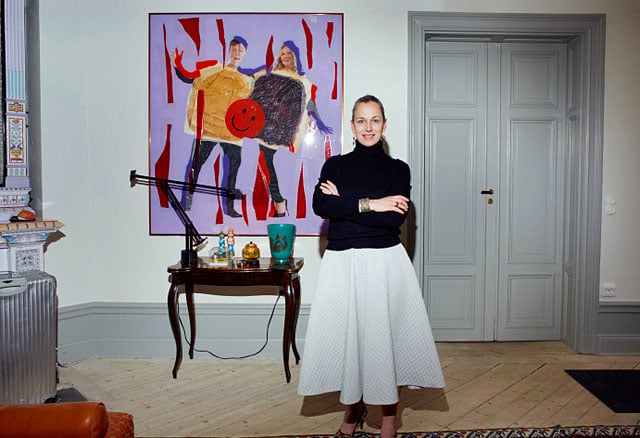
The couple's Stockholm apartment is home to a "water closet of curiosities."

Lee Carter

Family is key to Swedish collectors Emma and Andreas Ohlson’s views on art. Having both grown up in art-collecting families, the couple now has two college-aged children who’ve “inherited an interest in art,” according to their mother.
“We love visiting museums and galleries as a family, both at home and when traveling,” she said, citing the exhibitions “Hilma af Klint” at Stockholm’s Modern Museum and “Gillian Wearing: Wearing Masks” at the Guggenheim in New York as memorable stops. “The kids were blown away!”
That sense of adventure runs throughout the Ohlsons’s unconventional art collection, which focuses on emerging Swedish talent—particularly of the familial kind. The couple counts Andreas’s sister, who paints pastoral scenes of the family’s country estate, among the artists they collect, while one of their more recent acquisitions happens to be a friend of their son’s.
Of late, Emma has been nurturing new interests in the fields of interior design, craft, and antiques. She has held roles as CEO of Reijmyre Glasbruk, one of Sweden’s oldest glassworks, and head of fine art at Stockholm’s Auktionsverk, which was established in 1674, making it the world’s oldest auction house. Currently she’s developing an online dealership of vintage interiors and crafts called Nericia.
Emma has also joined the advisory board of Sweden’s Royal Institute of Art. Known as “Mejan,” the art school boasts some of the country’s most celebrated alumni, including Karin Mamma Andersson, Jockum Nordström, Gunnel Wåhlstrand, and Cecilia Edefalk.
Andreas Ohlson, meanwhile, has a background in media management and served as CEO of the Swedish edition of Metro newspapers. He has since turned his attention to industrial real estate, in addition to a “hilarious” (to quote Emma) new passion project: Swedish wrestling. Together with Howlin’ Pelle Almqvist, lead singer of Swedish band The Hives, Andreas has put his entrepreneurial spirit to good use by founding the Svensk wrestling league.
Since late 2022, the Ohlson family has called their country estate home (they also own a summer cottage in the south of Sweden), while maintaining their apartment in central Stockholm, where most of their collection can be found.
We caught up with Emma Ohlson for a glimpse into their eccentric family values and daring tastes in art.
What was your first purchase (and how much did you pay for it)?
I can’t be certain, but I think it was a small sculpture by Marie-Louise Ekman—a 3,000-kronor ($287) plexi-box assemblage of an injured donkey sitting in an anchovies tin. Hilarious! It was the perfect complement to the numerous paintings we brought with us from our parents to our first apartment. Both our parents have always been interested in art and we were lucky enough to set up home with limited-edition prints by the likes of Joe Tilson, James Rosenquist, Richard McLean, Öyvind Fahlström, and Salvador Dalí.
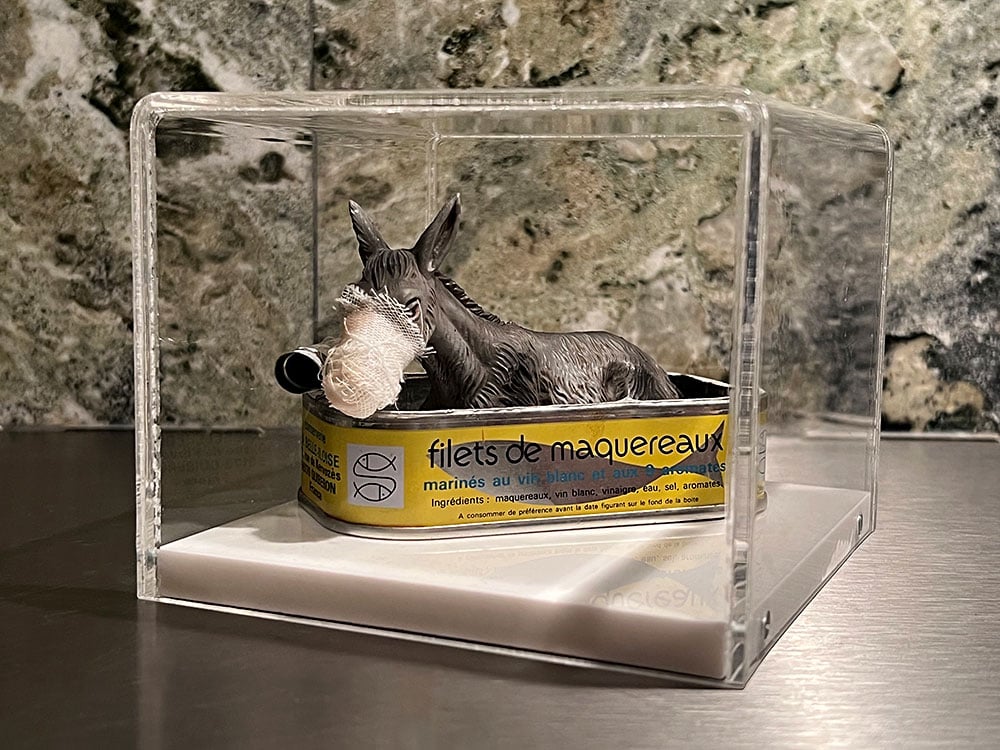
Donkey sculpture by Marie-Louise Ekman. Courtesy of Emma Ohlson.
What was your most recent purchase?
My husband and I recently bought a piece by the American artist Canyon Castator. Fin is a massive painting depicting a group of colorful and vulgar cartoon-like characters on a raft threatened by circling sharks. It hangs in our dining room and during family dinners we often have animated discussions over which character we identify with. Sometimes I feel like the wicked figure baiting the sharks with a juicy piece of meat, other times I can identify with the pale girl hanging on for dear life. My daughter is always the one with the mobile phone! I love Canyon’s sense of humor, and his ability to mix both digital and traditional techniques.
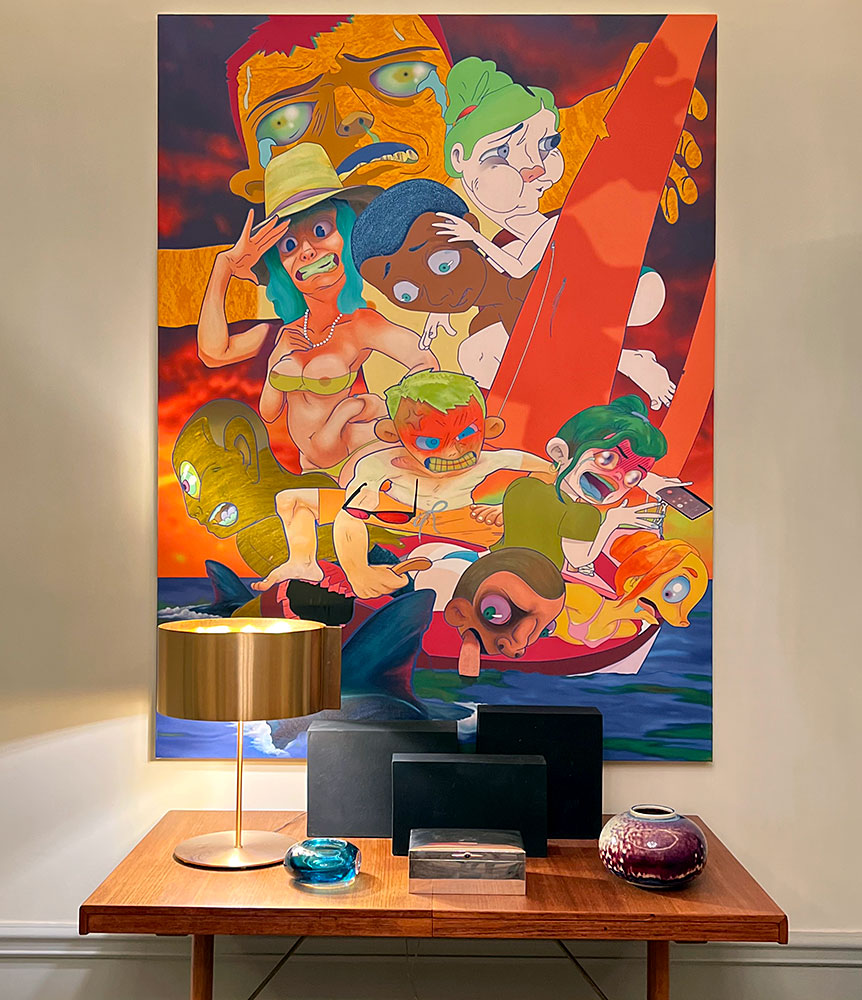
Canyon Castator, Fin (2021). Courtesy of Emma Ohlson.
Which works or artists are you hoping to add to your collection this year?
We are hoping to buy a piece by Szabolcs Bozó (Szabi). As with Canyon I find a lot of humor and joy in Szabi’s energetic and vibrant brushstrokes. Being half-Hungarian, I am a little partial to my countryman and his colorful characters.
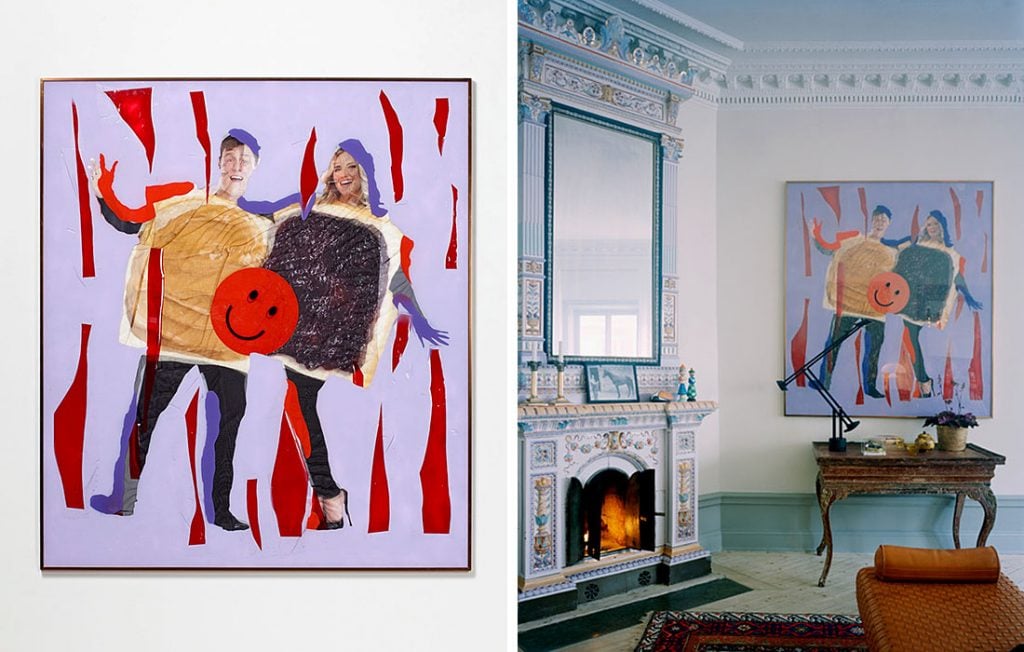
(Left) Alex Da Corte, Untitled (Peanut Butter and Jelly) (2014). Courtesy of Carl Kostyál. (Right) The artwork in Emma Ohlson’s home. Photo: Felix Odell. Courtesy of Emma Ohlson.
What is the most expensive work of art you own?
Not sure, my husband knows better. It could be our wonderful Alex Da Corte, Untitled (Peanut Butter and Jelly). His art is doing very well at auction at the moment. But I’m banking on a young talent I discovered through my son, Adrian Klingspor. They went to high school together. I bought one of his first pieces that he exhibited at the school’s open house. At only 19 he has a raw talent that I am convinced will develop into something really special.
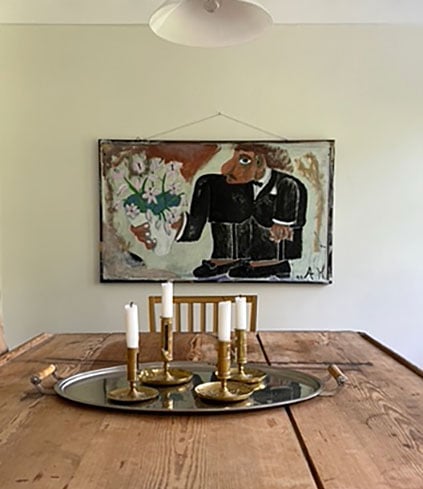
Adrian Klingspor, Förföraren (The Seducer) (2021). Courtesy of Emma Ohlson.
Where do you buy art most frequently?
Through our dear friend and gallerist Carl Kostyál. Together with his wife, Katharine, and their amazingly patient team, he represents some of the most exciting artists at the moment.
Is there a work you regret purchasing?
If I did, I have already sold it.
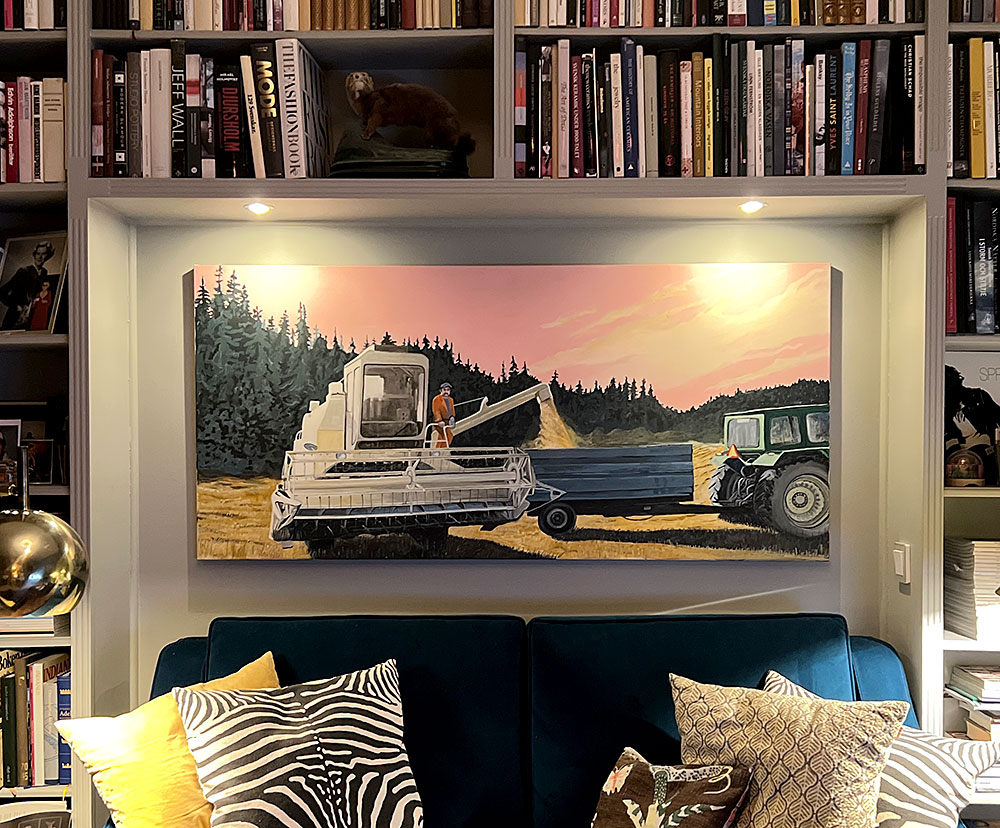
Katharina Rundqvist’s watercolor of Åke on a thresher. Courtesy of Emma Ohlson.
What work do you have hanging above your sofa?
We have a painting by my husband’s sister, Katharina Rundqvist. She is so talented but really only paints as a hobby. We absolutely love the watercolor depicting a much-beloved farmhand, Åke, on a thresher in one of the fields of the family’s country estate.
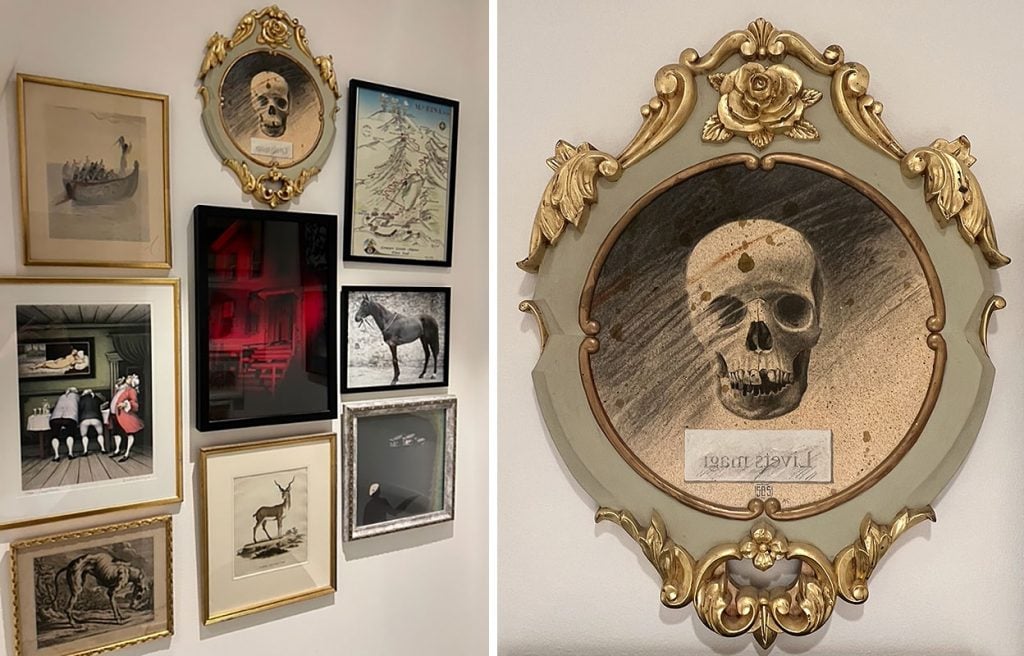
(Left) The “water closet of curiosities.” (Right) Sven-Bertil Svensson’s sketch of a skull. Courtesy of Emma Ohlson.
What about in your bathroom?
A jumble of smaller pieces. Souvenirs from trips, cartoon strips, personal photographs mixed with some “real” art. It is a water closet of curiosities. A personal favorite is a skull sketch by one of Sweden’s most famous altar painters, Sven-Bertil Svensson.
What is the most impractical work of art you own?
We have a sculpture composed of three black ceramic cubes. Though they are completely handmade by ceramicist Kennet Williamson, they are so perfect in shape and glazed in a matte, almost Vanta black color, that most guests don’t realize how fragile they are. Thankfully no accidents—yet.
What work do you wish you had bought when you had the chance?
A bronze sculpture by Ernst Billgren. It was one of my first gallery visits with the intention to buy. But I was way too young and poor. I think the sculpture was called Hermine (1998)—a bronze scalp with two braids sticking out. I frequently search auctions for it, but they rarely come up.
If you could steal one work of art without getting caught, what would it be?
Any one of Gerhard Richter’s “Abstraktes Bilder” series. I adore his abstract paintings. I remember them being described as “masterpieces of calculated chaos.” For me, calculated chaos is what both life and art is all about.
More Trending Stories:
Whoops! A Clumsy Art Fair Visitor Shattered a $42,000 Jeff Koons Balloon Dog Sculpture in Miami